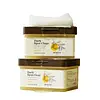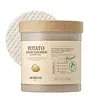What's inside
What's inside
 Key Ingredients
Key Ingredients

 Benefits
Benefits

 Concerns
Concerns

 Ingredients Side-by-side
Ingredients Side-by-side

Water
Skin ConditioningNiacinamide
SmoothingButylene Glycol
HumectantGlycereth-26
HumectantDipropylene Glycol
HumectantBetaine
HumectantCitrus Junos Fruit Extract
Skin ConditioningBis-Ethoxydiglycol Cyclohexane 1,4-Dicarboxylate
EmollientPolyglyceryl-10 Laurate
Skin ConditioningHydroxyacetophenone
Antioxidant1,2-Hexanediol
Skin ConditioningCaprylyl Glycol
EmollientCellulose Gum
Emulsion StabilisingEthylhexylglycerin
Skin ConditioningAdenosine
Skin ConditioningHibiscus Abelmoschus Extract
MaskingArginine
MaskingCarbomer
Emulsion StabilisingHydroxyethylcellulose
Emulsion StabilisingDioscorea Japonica Root Extract
Skin ConditioningPolyquaternium-51
Skin ConditioningSalvia Hispanica Seed Extract
EmollientLinum Usitatissimum Seed Extract
PerfumingCitrus Paradisi Peel Oil
MaskingDipotassium Glycyrrhizate
HumectantSodium Ascorbyl Phosphate
AntioxidantHippophae Rhamnoides Fruit Extract
Skin ConditioningCitrus Aurantium Bergamia Fruit Oil
MaskingMentha Viridis Leaf Oil
AstringentLitsea Cubeba Fruit Oil
MaskingCitrus Aurantium Amara Flower Oil
MaskingDisodium EDTA
Limonene
PerfumingWater, Niacinamide, Butylene Glycol, Glycereth-26, Dipropylene Glycol, Betaine, Citrus Junos Fruit Extract, Bis-Ethoxydiglycol Cyclohexane 1,4-Dicarboxylate, Polyglyceryl-10 Laurate, Hydroxyacetophenone, 1,2-Hexanediol, Caprylyl Glycol, Cellulose Gum, Ethylhexylglycerin, Adenosine, Hibiscus Abelmoschus Extract, Arginine, Carbomer, Hydroxyethylcellulose, Dioscorea Japonica Root Extract, Polyquaternium-51, Salvia Hispanica Seed Extract, Linum Usitatissimum Seed Extract, Citrus Paradisi Peel Oil, Dipotassium Glycyrrhizate, Sodium Ascorbyl Phosphate, Hippophae Rhamnoides Fruit Extract, Citrus Aurantium Bergamia Fruit Oil, Mentha Viridis Leaf Oil, Litsea Cubeba Fruit Oil, Citrus Aurantium Amara Flower Oil, Disodium EDTA, Limonene
Water
Skin ConditioningButylene Glycol
HumectantGlycerin
HumectantNiacinamide
Smoothing1,2-Hexanediol
Skin ConditioningHydroxyacetophenone
AntioxidantPPG-13-Decyltetradeceth-24
EmulsifyingBetaine
HumectantAllantoin
Skin ConditioningSodium Citrate
BufferingDipotassium Glycyrrhizate
HumectantSolanum Tuberosum Pulp Extract
SmoothingBeta-Glucan
Skin ConditioningCitric Acid
BufferingSodium Phytate
Sodium Hyaluronate
HumectantAmmonium Acryloyldimethyltaurate/Vp Copolymer
Helianthus Annuus Seed Oil
EmollientMadecassoside
AntioxidantSodium Ascorbyl Phosphate
AntioxidantGlyceryl Acrylate/Acrylic Acid Copolymer
HumectantPogostemon Cablin Leaf Oil
MaskingDipropylene Glycol
HumectantSclerotium Gum
Emulsion StabilisingPvm/Ma Copolymer
Emulsion StabilisingSalvia Officinalis Oil
MaskingHydrogenated Lecithin
EmulsifyingPolyglyceryl-10 Laurate
Skin ConditioningCentella Asiatica Extract
CleansingAsiaticoside
AntioxidantMadecassic Acid
Skin ConditioningAsiatic Acid
Skin ConditioningLavandula Angustifolia Oil
MaskingCaffeine
Skin ConditioningSalvia Sclarea Oil
MaskingRosmarinus Officinalis Leaf Oil
MaskingCaprylyl Glycol
EmollientWater, Butylene Glycol, Glycerin, Niacinamide, 1,2-Hexanediol, Hydroxyacetophenone, PPG-13-Decyltetradeceth-24, Betaine, Allantoin, Sodium Citrate, Dipotassium Glycyrrhizate, Solanum Tuberosum Pulp Extract, Beta-Glucan, Citric Acid, Sodium Phytate, Sodium Hyaluronate, Ammonium Acryloyldimethyltaurate/Vp Copolymer, Helianthus Annuus Seed Oil, Madecassoside, Sodium Ascorbyl Phosphate, Glyceryl Acrylate/Acrylic Acid Copolymer, Pogostemon Cablin Leaf Oil, Dipropylene Glycol, Sclerotium Gum, Pvm/Ma Copolymer, Salvia Officinalis Oil, Hydrogenated Lecithin, Polyglyceryl-10 Laurate, Centella Asiatica Extract, Asiaticoside, Madecassic Acid, Asiatic Acid, Lavandula Angustifolia Oil, Caffeine, Salvia Sclarea Oil, Rosmarinus Officinalis Leaf Oil, Caprylyl Glycol
 Reviews
Reviews

Ingredients Explained
These ingredients are found in both products.
Ingredients higher up in an ingredient list are typically present in a larger amount.
1,2-Hexanediol is a synthetic liquid and another multi-functional powerhouse.
It is a:
- Humectant, drawing moisture into the skin
- Emollient, helping to soften skin
- Solvent, dispersing and stabilizing formulas
- Preservative booster, enhancing the antimicrobial activity of other preservatives
Betaine is a common humectant (a substance that promotes retention of moisture). It's known to be gentle on the skin and can help balance hydration.
This ingredient is best for improving hydration and soothing irritated skin. Studies also show it helps even out skin tone.
Fun fact: Betaine is naturally created in the skin and body. The kind found within cosmetic products can be either plant-derived or synthetic.
Another name for betaine is trimethylglycine.
Learn more about BetaineButylene Glycol (or BG) is used within cosmetic products for a few different reasons:
Overall, Butylene Glycol is a safe and well-rounded ingredient that works well with other ingredients.
Though this ingredient works well with most skin types, some people with sensitive skin may experience a reaction such as allergic rashes, closed comedones, or itchiness.
Learn more about Butylene GlycolCaprylyl Glycol is a humectant and emollient, meaning it attracts and preserves moisture.
It is a common ingredient in many products, especially those designed to hydrate skin. The primary benefits are retaining moisture, skin softening, and promoting a healthy skin barrier.
Though Caprylyl Glycol is an alcohol derived from fatty acids, it is not the kind that can dry out skin.
This ingredient is also used as a preservative to extend the life of products. It has slight antimicrobial properties.
Learn more about Caprylyl GlycolDipotassium Glycyrrhizate comes from licorice root.
Extracts of licorice have demonstrated to have antibacterial, anti‐inflammatory, antiviral, antioxidant properties.
One component, glabridin, has extra potent antioxidant and soothing properties. It has also been found to block pigmentation from UVB rays in guinea pigs.
Licorice Root also contains a flavonoid. Flavonoids are a natural substance from in plants. Flavonoids also have antioxidant properties.
Another component, glycyrrhizin, has been found to have anti-inflammatory and antimicrobial benefits. This may make licorice root extract effective at treating acne. However, more research is needed to support this.
Liquiritin is one of the flavone compounds found in licorice. It has been found to help lighten skin by preventing tyrosinase from reacting with tyrosine. When the two react, protein is converted to melanin. Melanin is the substance in your body that gives your features pigmentation.
Licorice root is native to Southern Europe and Asia. It has been used in traditional Chinese medicine to help with respiratory issues.
Learn more about Dipotassium GlycyrrhizateDipropylene Glycol is a synthetically created humectant, stabilizer, and solvent.
This ingredient helps:
Dipropylene glycol is technically an alcohol, but it belongs to the glycol family (often considered part of the ‘good’ alcohols). This means it is hydrating and gentle on skin unlike drying solvent alcohols like denatured alcohol.
As a masking agent, Dipropylene Glycol can be used to cover the smell of other ingredients. However, it does not have a scent.
Studies show Dipropylene Glycol is considered safe to use in skincare.
Learn more about Dipropylene GlycolHydroxyacetophenone is antioxidant with skin conditioning and soothing properties. It also boosts the efficiency of preservatives.
This ingredient is not irritating or sensitizing.
Niacinamide is a multitasking form of vitamin B3 that strengthens the skin barrier, reduces pores and dark spots, regulates oil, and improves signs of aging.
And the best part? It's gentle and well-tolerated by most skin types, including sensitive and reactive skin.
You might have heard of "niacin flush", or the reddening of skin that causes itchiness. Niacinamide has not been found to cause this.
In very rare cases, some individuals may not be able to tolerate niacinamide at all or experience an allergic reaction to it.
If you are experiencing flaking, irritation, and dryness with this ingredient, be sure to double check all your products as this ingredient can be found in all categories of skincare.
When incorporating niacinamide into your routine, look out for concentration amounts. Typically, 5% niacinamide provides benefits such as fading dark spots. However, if you have sensitive skin, it is better to begin with a smaller concentration.
When you apply niacinamide to your skin, your body converts it into nicotinamide adenine dinucleotide (NAD). NAD is an essential coenzyme that is already found in your cells as "fuel" and powers countless biological processes.
In your skin, NAD helps repair cell damage, produce new healthy cells, support collagen production, strengthen the skin barrier, and fight environmental stressors (like UV and pollution).
Our natural NAD levels start to decline with age, leading to slower skin repair, visible aging, and a weaker skin barrier. By providing your skin niacinamide, you're recharging your skin's NAD levels. This leads to stronger, healthier, and younger looking skin.
Another name for vitamin B3 is nicotinamide. This vitamin is water-soluble and our bodies don't store it. We obtain Vitamin B3 from either food or skincare. Meat, fish, wheat, yeast, and leafy greens contain vitamin B3.
The type of niacinamide used in skincare is synthetically created.
Learn more about NiacinamidePolyglyceryl-10 Laurate is an ester of lauric acid and Polyglycerin-10.
Polyglyceryl-10 Laurate is a cleansing agent and emulsifier. It helps gather dirt, oil, and other pollutants to be rinsed away. As an emulsifier, it helps prevent ingredients from separating, such as oil and water.
Polyglyceryl-10 Laurate may not be fungal acne safe.
Learn more about Polyglyceryl-10 LaurateSodium Ascorbyl Phosphate is a form of Vitamin C. It is the salt of ascorbic acid.
This ingredient is more gentle than ascorbic acid. It is also more stable when exposed to light and oxygen.
Vitamin C helps reduce redness, improve skin texture, reduce the effects of aging, reduce the visibility of dark spots, and brighten skin.
Your skin uses Vitamin C to produce collagen and collagen production plays a role in having a strong skin barrier and plump skin. As an antioxidant, this ingredient also helps reduce the signs of aging such as fine-lines and wrinkles.
VItamin C helps brighten skin by blocking the process of skin darkening.
In a 2011 study, Sodium Ascorbyl Phosphate was found to have antibacterial properties. This may help treat acne.
Read more about other types of Vitamin C:
Learn more about Sodium Ascorbyl PhosphateWater. It's the most common cosmetic ingredient of all. You'll usually see it at the top of ingredient lists, meaning that it makes up the largest part of the product.
So why is it so popular? Water most often acts as a solvent - this means that it helps dissolve other ingredients into the formulation.
You'll also recognize water as that liquid we all need to stay alive. If you see this, drink a glass of water. Stay hydrated!
Learn more about Water